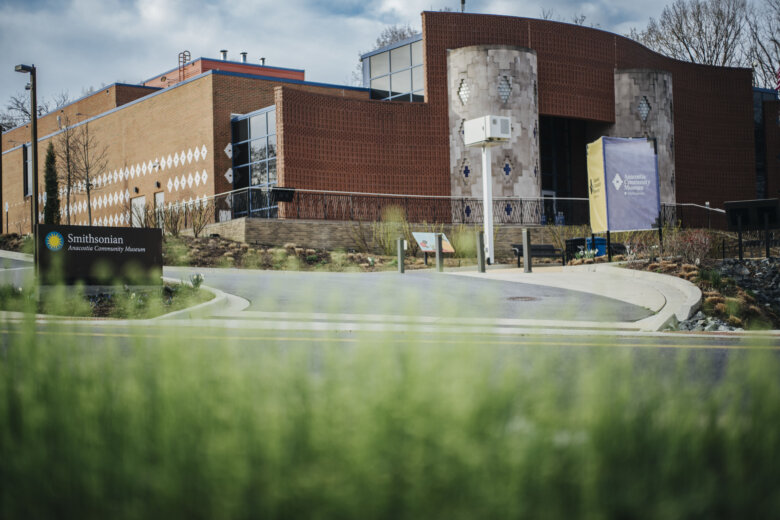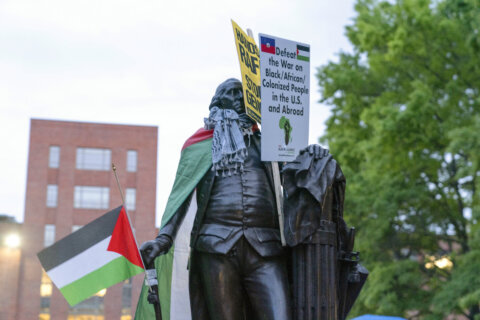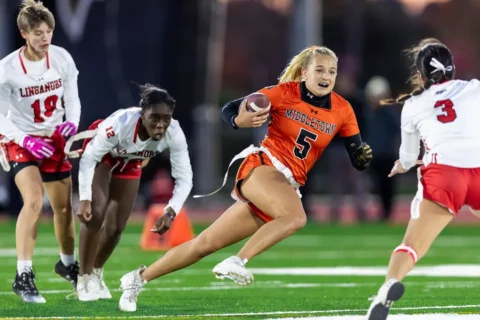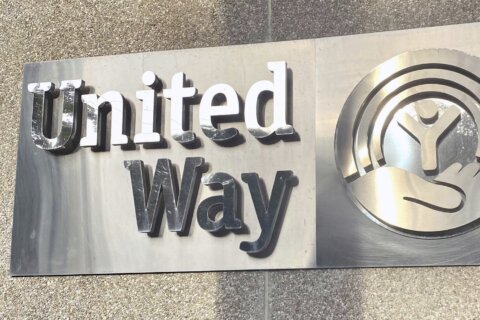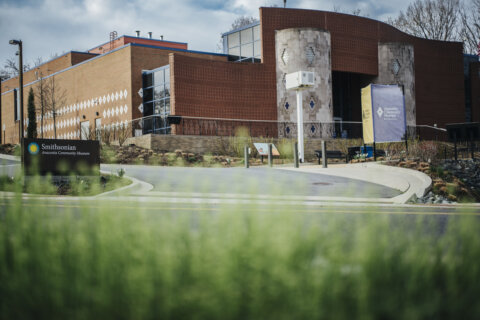
Throughout February, WTOP is celebrating Black History Month. Join us on air and online as we bring you the stories, people and places that make up our diverse community.
When you walk across D.C.’s National Mall or into the suburbs in nearby Maryland and Virginia, you are almost certain to come across one of the dozens of museums that call this region home.
Given the national political climate’s growing challenges to education — learning about the institution of slavery and the presence of Critical Race Theory among them — are these local museums changing how they share critical pieces of African American history?
To answer this question, WTOP reached out to curators at local museums across the D.C. area.
‘Looking at our relationship with slavery’
Over the past 98 years of Black History Month celebrations, Prince George’s County has spent almost half a century preserving Black history. WTOP discussed that work with historian of Black history and site manager Artura Jackson with the Maryland-National Park and Planning Commission Department of Parks and Recreation for the county.
“All of our museums throughout the parks system are working to either reinvigorate their stories — tell their stories in new, exciting and complex ways — and/or add to the story of Black history through the month of February and beyond,” Jackson said.
As the county’s historian, Jackson said she has seen few, if any, attempts to pull away from the region’s past. She has, however, found more opportunities to acknowledge and highlight how the museums’ land and sites fit into the region’s shared story.
“We are really going back and looking at our relationship with slavery. Many of our museums sit on sites of formerly enslaved people. … A lot of our museums that are former sites of enslavement are going back and revisiting their narratives, and their exhibitions and relationship to slavery,” she said.
This relationship is personal for Jackson. From her perspective, Jackson said, she has learned more about the region by working alongside descendants of enslaved persons.
“To say, ‘Hey, let’s turn this space over to you. Let’s allow you to interpret this space, let’s allow you to curate this space.’ I think that is important work. I think that is what people desire,” she said.
She said this was especially important for visitors who, like her, are descendants of enslaved people.
“As a descendant of an enslaved person, I know that it’s important to have autonomy over that space. The names, the streets — they reflect the white landowner. But what we tell and how we tell the story from the spaces is how they are remembered,” she told WTOP.
Jackson said these memories can feel especially challenging for some visitors and people in her field, especially in our political climate.
“CRT’s a very real thing for a lot of people — Critical Race Theory and the fear of it. I don’t think we’ve felt it just yet, but I think the impending fear of ‘What does it look like for historians?’ or ‘What does it look like when your profession or your occupation is being censored?'” Jackson said. “This is probably the first time in a long time that history has come under question.”
Critical Race Theory, a way of thinking about America’s history through the lens of racism, was developed by scholars during the 1970s and 1980s in response to what they viewed as a lack of racial progress following the civil rights legislation of the 1960s. But many opponents see it as an effort to rewrite American history.
However, Jackson told WTOP that vibrant, detailed accountings of the past are necessary, which is part of the reason why it is so important to visit local museums.
“It’s important for people to visit local museums. We live in Washington, D.C., so you have the Smithsonian. … It’s hard to be a small museum in the shadows of this big institution, but I think it’s people’s engagement in local history, and their desire to know where they’re from, that really helps us stay alive, and to stay relevant,” she said.
Anacostia honors ‘long, rich lineage’ year-round
While the Smithsonian museums across the region only publicly show a fraction of their collection at a time, some smaller community museums attached to the institution are working to showcase local Black history all year.
Over at the Smithsonian Anacostia Community Museum, senior curator Samir Meghelli said the Smithsonian Museum is continuously exploring moments in Black history despite any challenges that may arise.
“Black History Month in particular is an opportunity to shine a light on the work that we’re always doing, and really amplify the work that we’re doing in our research, in our exhibitions, collections, public programs. To highlight particularly local Black history and culture in the Washington, D.C. region,” Meghelli said.
He tells WTOP that its Anacostia Community Museum, which predates the federal recognition of Black History Month by some three years, remains steadfast in Smithsonian’s approach to sharing history, no matter the content.
“The Smithsonian Anacostia Community Museum has been around for 57 years. I think we pride ourselves on how we’ve never wavered from our mission of telling the rich and unvarnished truth of our history in this country,” Meghelli said.
He also said the Anacostia Community Museum is working to continue to inform, inspire and bring communities that visit the museum together.
“We’re not doing anything different,” Meghelli said. “We’re continuing to do that work that we’ve done for five decades.”
As for the political climate around significant events, like the death of George Floyd, or concerns over teaching Black history, Meghelli said his museum isn’t hopeful.
“I think, if anything, it’s really offering an opportunity. People are hungry for this history. There’s a need for it to be shared more widely, and to be embraced,” Meghelli told WTOP.
This Black History Month, Meghelli said the museum’s building is set to close for the installation of the next exhibition. However, visitors won’t be kept in the dark through March.
“While our building is closed for the installation of that new exhibit, we are spotlighting a new digital project,” he said, adding that the digital exhibition DC Women Speak “highlights the many hundreds of oral histories in our collections at the museum, everyday stories from local women who’ve made a difference in Washington.”
Next month’s showing of “A Bold and Beautiful Vision” is set to explore a long, rich history of African American educators who learned or taught creatives across the District.
Presidential history unvarnished on display at Mount Vernon
George Washington’s Mount Vernon is among those spaces that find themselves directly connected to the namesake, grounds and lineage of a person whose history is deeply connected to the country’s past, good and bad.
Jeremy Ray, senior director of interpretation, told WTOP that, “Of course, Mount Vernon was the home of George Washington but it was a site of enslavement. So, for us, telling the story of the history of the people who were enslaved here — early Black Americans — that’s something that we do year-round.”
Ray told WTOP that people visiting the sites have likely seen some of the work Mount Vernon does to share the individual stories of enslaved persons around the site, and most are extremely interested in learning all of Mount Vernon’s past.
“Predominantly, our audience is very interested in this story. We do get some people who think, ‘It should be more about George Washington,’ and some people who think, ‘Hey, you should be telling more of the story of the enslaved.’ But the vast majority of our audience is just interested in learning about who these people are, how it interacts with George Washington, with early American history,” Ray said.
Despite the political climate, Ray said, Mount Vernon also saw an increase in interested visitors looking for more parts of Black history as it connects to former President Washington.
“As far as political climate, for us, it’s really been not so bad. It’s just continuing the kind of thirst and hunger for that information. Really, after 2020, we had more people reaching out saying, ‘I don’t really know all that much and you all have so much information,'” Ray said.
His suggestion for visitors looking to learn more about the connections between Mount Vernon and Black American history: Come away with a full story.
“It’s very easy when you’re learning about early American history to focus on stories and ideas of freedom and liberty,” Ray said. “The founders were absolutely incredible at creating systems that allow us to create a more perfect union. But in order to perfect you have to understand where there were issues in the past that weren’t that open for everybody.”
Get breaking news and daily headlines delivered to your email inbox by signing up here.
© 2024 WTOP. All Rights Reserved. This website is not intended for users located within the European Economic Area.

